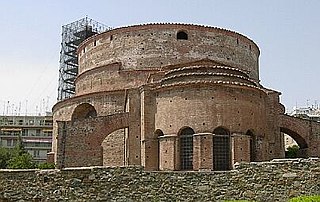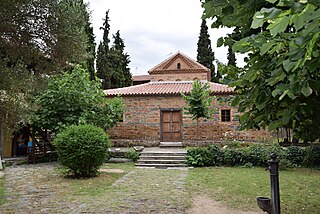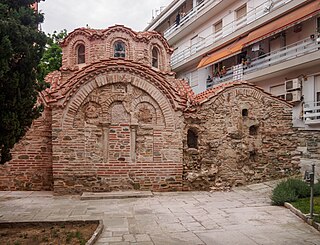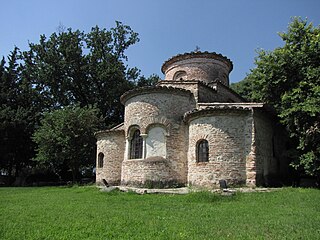
The Arch of Galerius or Kamara (Καμάρα) and the Rotunda (Ροτόντα) are neighbouring early 4th-century AD monuments in the city of Thessaloniki, in the region of Central Macedonia in northern Greece. As an outstanding example of early Byzantine art and architecture, in addition to the importance of the Rotunda as one of the earliest Christian monuments in the Eastern Roman Empire, both sites were inscribed on the UNESCO World Heritage List in 1988 as part of the Paleochristian and Byzantine monuments of Thessaloniki.

A templon is a feature of Byzantine churches consisting of a barrier separating the nave from the sanctuary near the altar.

The Church of Saint Demetrius, or Hagios Demetrios, is the main sanctuary dedicated to Saint Demetrius, the patron saint of Thessaloniki, dating from a time when it was the second largest city of the Byzantine Empire. Since 1988, it has been on the UNESCO World Heritage List as a part of the site Paleochristian and Byzantine monuments of Thessaloniki.

The Hagia Sophia in Thessaloniki, Greece. With its current structure dating from the 7th century, the church is one of the oldest churches in the city still standing today. Because of its outstanding Byzantine art and architecture, in addition to its importance in early Christianity, it is one of several monuments in Thessaloniki listed as a UNESCO World Heritage Site in 1988.

The Church of Panagia Chalkeon is an 11th-century Byzantine church in the northern Greek city of Thessaloniki. The church's well-preserved Byzantine architecture and testimony to the importance of Thessaloniki in early and medieval Christianity led ti to be inscribed on the UNESCO World Heritage List in 1988 along with other Paleochristian and Byzantine monuments of Thessaloniki.

The Church of the Holy Apostles is a 14th-century Byzantine church in the northern Greek city of Thessaloniki. Because of its outstanding Byzantine mosaics and architecture, and its testimony to the importance of Thessaloniki in early and medieval Christianity, the church is inscribed on the UNESCO World Heritage List along with other Paleochristian and Byzantine monuments of Thessaloniki.

The Church of Saint Nicholas Orphanos is an early 14th-century Byzantine church in the northern Greek city of Thessaloniki. Covered in outstanding Byzantine frescoes, the church is inscribed on the UNESCO World Heritage List along with other Paleochristian and Byzantine monuments of Thessaloniki, demonstrating the importance of Thessaloniki in early Christian history.

The Church of the Acheiropoietos is a 5th-century Byzantine church in the northern Greek city of Thessaloniki, Central Macedonia. It is located in the city's centre, at Agias Sofias street opposite Makedonomachon square. Because of its outstanding early Byzantine architecture, the church was inscribed on the UNESCO World Heritage List in 1988 along with other Paleochristian and Byzantine monuments of Thessaloniki.
Panagia is a village in the northeastern part of the island of Lemnos, Greece. It is part of the municipal unit of Moudros. In 2011 its population was 383 people, including the small village Kortisonas.

The Walls of Thessaloniki are the 4 kilometer-long city walls surrounding the city of Thessaloniki during the Middle Ages and until the late 19th century, when large parts of the walls, including the entire seaward section, were demolished as part of the Ottoman authorities' restructuring of Thessaloniki's urban fabric. The city was fortified from its establishment in the late 4th century BC, but the present walls date from the early Byzantine period, ca. 390, and incorporate parts of an earlier, late 3rd-century wall. The walls consist of the typical late Roman mixed construction of ashlar masonry alternating with bands of brick. The northern part of the walls adjoins the acropolis of the city, which formed a separate fortified enceinte, and within it lies another citadel, the Heptapyrgion, popularly known by the Ottoman translation of the name, Yedi Kule.

The Church of Hosios David is a late 5th-century church in Thessaloniki, Greece. During the Byzantine times, it functioned as the katholikon of the Latomos Monastery, and was adorned with rich mosaic and fresco decoration, which was renewed in the 12th–14th centuries. Today, the surviving examples are of high artistic quality, especially the apse mosaic Icon of Christ of Latomos. Under Ottoman rule, the building was converted into a mosque, until it was reconsecrated as a Greek Orthodox church in 1921, thus receiving its present name. In 1988, this monument was included among the Paleochristian and Byzantine monuments of Thessaloniki on the list of World Heritage Sites by UNESCO.

The Byzantine Bath of the Upper Town in Thessaloniki is one of the few and best preserved of the Byzantine baths that have survived from the Byzantine period in Greece. It is located on the Theotokopoulou Street in the Upper Old Town of Thessaloniki.

The Church of Prophet Elijah is a 14th-century church in Thessaloniki, Greece, and a UNESCO World Heritage Site.

The Church of Saint Panteleimon is a late Byzantine church Built in the 14th century in Thessaloniki, Greece. Because of its well-preserved Byzantine architecture and its testimony to the importance of Thessaloniki to early and medieval Christianity, the church was inscribed on the UNESCO World Heritage List in 1988 along with several other Paleochristian and Byzantine monuments of Thessaloniki.

The Church of Saint Catherine is a late Byzantine church in the northwestern corner of the Ano Poli, Thessaloniki, Greece.

The Church of Saint Symeon in Mytilene is a church on the island of Lesvos in the city of Mytilene close to the old market. In the archive of the Metropolitan Church of Mytilene documentation can be found regarding the church on page 30a and 38B beginning 1700. The specific church is mentioned and it may have been built around 1700. A church was built on the site around 1885-1891, it replaced the old church which was smaller and ready to be torn down. This maybe attributed to an earthquake in 1867. There exist architectural plans that show a huge church was on the site that predates the building of 1885. Three saints are venerated by the church; Saint Simeon Stylites of Syria, Saint Symeon Stylites of Lesbos and Simeon

The Church of the Saviour is a 14th-century Byzantine chapel in Thessaloniki, Greece. It is a UNESCO World Heritage Site as one of the Paleochristian and Byzantine monuments of Thessaloniki. The church has been dated to about 1350, based on a coin found within its dome during archaeological investigations and restoration work following the 1978 Thessaloniki earthquake.

Vlatades Monastery or Vlatadon Monastery is a monastery in Ano Poli, Thessaloniki, Greece. Built in the 14th century during the late era of the Byzantine Empire, it is a UNESCO World Heritage Site along with 14 other Paleochristian and Byzantine monuments of Thessaloniki because of its Byzantine architecture and importance of Thessaloniki during early and medieval Christianity.

Panagia Kontariotissa or Kountouriotissa, formally the Church of the Dormition of the Theotokos, is a very well preserved Byzantine monument in Pieria, Greece. "Kontariotissa" refers to the name of the modern community that originated near the church.

The Metropolitan Church of Saint Gregory Palamas is a Church in Thessaloniki, Greece. It belongs to the Metropolis of Thessaloniki and is under the administration of the Orthodox Church of Greece. It is dedicated to Saint Gregory Palamas, a 14th-century theologian known for his writings and teachings on hesychasm.











































